
A typical short freight in the last years of service on the line. A Di.2.-class hydralic, and a couple of G4 boxcars and the baggagecar,
the european version of the american caboose.
Inmagine yourself, that you can build a modest end of the branchline terminal, with ALL buildings from available kits!!! This feature is based on an article on Po Sporet, issue No. 53, by Thor Bjerke.
All black and white images are from that article and are shot by Thor Bjerke, Per Herman Sörlie and the historical photos Totens Historiska Samling. Color photos by Olavi Ahokas, except for modelphotos by Artitech/NMJ
Historical background.
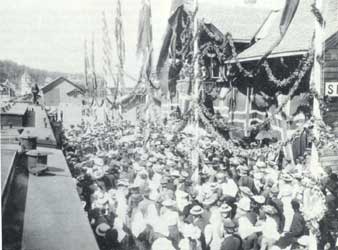
An image dating from the grand opening of the line in Skreia 26.th of November 1902..
The earliest plans for a railroadline to Gjövik are dating as early as 1873. The plan was to construct a line from Kristinania (Oslo) by Gjövik to Lllehammar. But the construction was decided in 1894, and the plans were altered, and the line Kristiania - Lillehammar was constructed by hamar instead. This made clear of the need of a separate line to Gjövik, which is rich on argicultural production. The work started in 1898 and one year later the plans were added with a branch line to Skreia. The work started very soon and in 1901 the railline was constructed to Reinsvold, and the branchline was completed and opened for service in 26.th of November 1902 by Prince Carl.
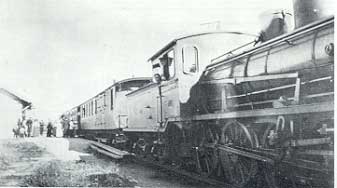
A type 18c making a stop in Bilit in the early years.
In the early days, there were 3 daily runs on the line, needing one hour to run the 22 kilometers from Skreija to Reinsvold . The morningrun, started at 6.40 and arrived in Gjövik 8.40, departing back at 11.00 and arriving in Skreija at 13.00. the two other runs terminated at Reinsvold leaving Skreia at 17.00 and at 19.40 and departing back at 18.20 and 21.00. The trains were hauled by type 15c class 2-6-0 No.142, built in 1902 by Thune. But soon the engine was prooved to be to light for the service and was replaced by heavier 2-6-0.s of type 18.s. To provide more economical service on the passanger runs during the twenties, a new type of railcars were delivered to NSB. on the Skreia line they showed up in the late summer of 1929, they speeded up the service and 15 minutes were cut from the schedule, though the railcars made more stops. By this date, the service was increesed to 7 daily runs, five of them terminated in Gjövik, steam was only used on two of these runs. The steamengine and the railcar stayed the nights in Skreia.
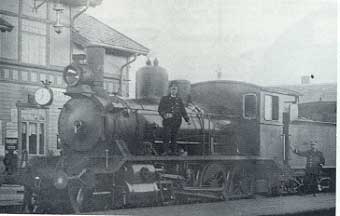
A type 18c No. 226 (Hamar 1911) has just arrived in Reinsvold with a train from Skreia
In the thirties the schedules were slighly changed, to make connection with the railcar service between Eina and Gjövik. The railcar could pull when needed, up to six passengercars, but was more commonly coupled to an old car with side doors directly to the compartments modified to a trailer. New heavier 4-axeled railcars were put in service at just before WW II. During the war due the shortage of fuel, the railcars were replaced by steamers, which stayed the night in Skreia. Postwar power was usually type 22, more commonly type 24, sometimes by type 26 and by type 34a an US built prarie (2-6-2) tanks. The first railcars used on the line as the fuel shortages came to an end, were ex. German VT 25 class, NSB Cmdo 9.s which also handeled the passenger service on the nearby Valdresline. These railcars were in poor mechanical condition, needing much attention at the shops, and in 1955 they were replaced by Cmdo type 3. These railcars were not suited for the cold winters in the area and soon they were replaced by modern railcars of type 86 in 1958. In this period the improved busservice and increased numbers of private cars, decreased the number of passangers and the last passanger run was in 14.th of October 1963. The last steam run on freight was in 1968 and the freights were handeled by Di2-class untill the line was closed in 1987.
The last days in Skreia Line.

The station building and the busservice.
From the very beginning the line was kept busy hauling arhciculturalproducts to the very end of service. In fact the line was in the early days known as Potatoline.. But during the the last decades the renevue declined drasticly, mostly lost to the ever improved free public roads. The freights ran in the last years only to Lena which was the last station with an operator, but when needed all the way to Skreia. The line crossed ten public roads, each protected by manually operating barricades, using the train crew of 3. this ment that the train had to stop at each crossing, turn the barricades to stop the roadtraffic and halt again to place the barricades to orginal position. Those roads that did not have barricades, a crew member acted as a flagman.
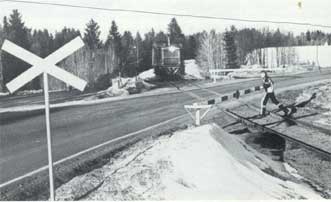
A local freight hauled by Di2 has stopped at the public road crossing.
The road of way eventually started to show signs of the time, the rail was mainly the same light rail dating from opening of the line. The line was approved to use axle loading of 12 tons, later this was increased to 16 tons.
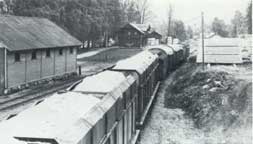
Woodchip loading at Skreia in 1986.
NSB started to haul woodchips for Kvaerum Bruk on the line in 1982 and a loadingramp was constructed in Skreia in 1982 (now raized). The local was extended to run to Skreija, but only two years later as the costumer was taken over by new owner, the service ceased. The local ran only to Lena and hauled only occationally a couple of boxcars of potatoes to Skreia and a tankcar of melasses to Lena, occationally, Fjellskjoepet used the railservice for their own products.

The woodchip ramp when it was new in may of 1983. There are no kit available but this image shows the construction of it.
Photo by Thor Bjerke from Po Sporet #37.
Stations on the Skreia Line
The distance as from Reinsvold.
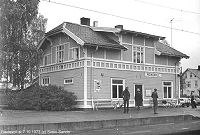
Reinsvold
Photo by NJK forskningsgruppen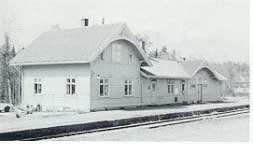
Böverbru 3.99 km from Reinsvold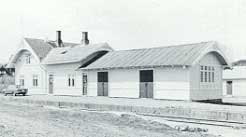
Kolbu 9.09 km from Reinsvold
Lena 14.05 km from Reinsvold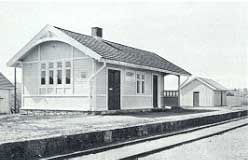
Kraby 16,13 km from Reinsvold- Bilit 18,93 km from Reinsvold
- Skreia 21,97 km from Reinsvold